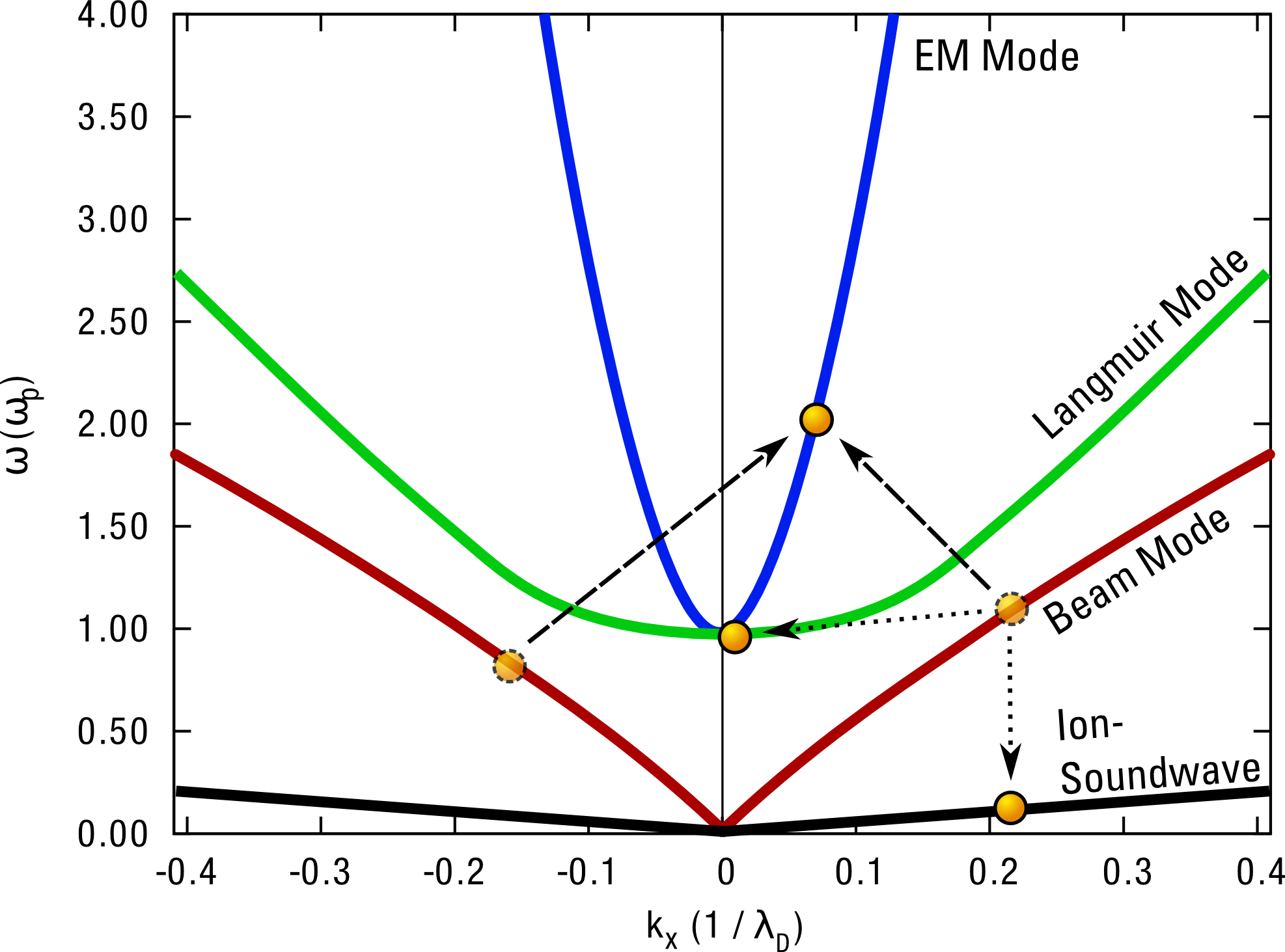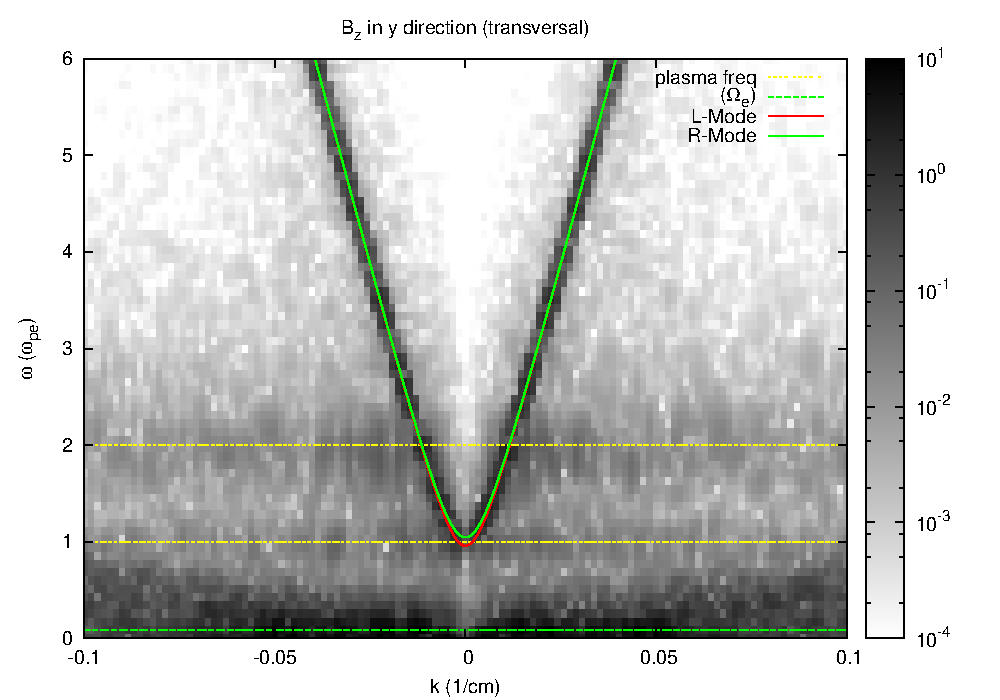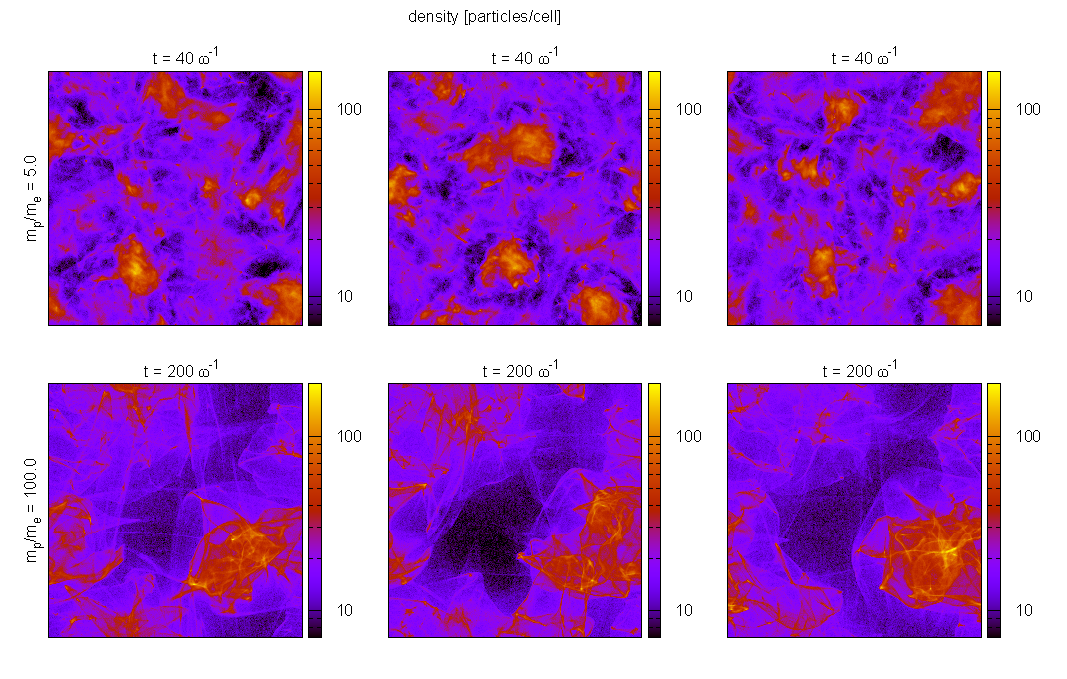Research - Plasma
Astrophysics and plasma physics are very closely related: Almost all objects in astrophysics are in the plasma state. Accordingly, many astrophysical processes can only be understood if plasma physics is taken into account. I am mainly concerned with instabilities and nonlinear interactions in plasmas. In addition to these pure plasma-physical effects, plasma also plays a role in my research href = "acceleration.shtml"> particle acceleration , turbulence and transport theory play an important role.
Nonlinear interactions
Plasmas have a large number of eigenmodes into which fluctuations can be broken down. The first nonlinear order of interaction is the three-wave interaction. Many non-linear phenomena in plasma physics can be explained with this simple description. The approach is to consider plasma waves as pseudoparticles with momentum and energy, with which the collision of two waves can be described by the conservation of momentum and energy.
For the description of turbulence in incompressible MHD plasmas, such a consideration then e.g. directly the anisotropic turbulence model of Goldreich & amp; Sridhar. An analytical calculation for dispersive plasmas ( Three-wave interactions of dispersive plasma waves propagating parallel to the magnetic field (Spanier and Vainio 2008 arXiv e-prints) ) then also shows the limits of a simple description: Due to dispersion effects, the momentum and energy conservation equations quickly become complex. However, it can also be shown that the pseudoparticle description also receives the angular momentum. This in turn has consequences for the polarization of plasma waves.
A very concrete application of three-wave interaction are Type II radio bursts as observed on the Sun. The measurements show not only a fundamental emission but also an emission at the first harmonic. Computer simulations with the ACRONYM code made it possible to recreate this scenario ( Nonlinear Wave Interactions as Emission Process of Type II Radio Bursts (Ganse, Kilian, Spanier, and Vainio 2012 The Astrophysical Journal) ). It is assumed here that electrons are accelerated on a shock front. These electrons then stimulate a beam mode - a special plasma mode that exists when high-energy particles flow through the plasma. Several wave interactions can then explain both fundamental and harmonic emissions.
 |
||
| Possible interactions of waves in the Type II scenario from Nonlinear Wave Interactions as Emission Process of Type II Radio Bursts (Ganse, Kilian, Spanier, and Vainio 2012 The Astrophysical Journal) . Opposing beam modes can interact with EM modes. Depending on which combination is chosen, the result is fundamental or harmonic emission. |
Since little is known about the geometry of the emission region on the sun, each scenario can be run through with numerical methods: Emission of Type II Radio Bursts - Single-Beam Versus Two-Beam Scenario (Ganse, Kilian, Vainio, and Spanier 2012 Solar Physics) , Fundamental and harmonic plasma emission in different plasma environments (Ganse, Kilian, Spanier, and Vainio 2014 Astronomy and Astrophysics) . By comparing numerous realizations with measurement data, it is then possible to narrow down the physical scenario more closely.
 |
||
| Energy distributin in k-ω-space from a PiC simulation (Emission of Type II Radio Bursts - Single-Beam Versus Two-Beam Scenario (Ganse, Kilian, Vainio, and Spanier, 2012 Solar Physics )). |
Instabilities
Another important aspect of my research is instabilities in plasmas. In particular kinetic instabilities - as they are e.g. are excited by high-energy particles in plasmas. One of the first applications of the ACRONYM code was also the simulation of an instability: The filamentation instability ( The Influence of the Mass Ratio on Particle Acceleration by the Filamentation Instability (Kilian, Burkart, and Spanier 2012 , High Performance Computing in Science and Engineering '11) , The Influence of the Mass Ratio on the Acceleration of Particles by Filamentation Instabilities (Burkart, Elbracht, Ganse, and Spanier 2010 The Astrophysical Journal) ) The filamentation instability arises in unmagnetized plasmas when two warm plasmas flow against each other. The filament instability can - similar to the related Weibel instability - generate seed magnetic fields in unmagnetized plasmas and at the same time accelerate charged particles.
 |
||
| Formation of magnetic flux tubes by the filamentation instability. The Influence of the Mass Ratio on the Acceleration of Particles by Filamentation Instabilities (Burkart, Elbracht, Ganse, and Spanier 2010 The Astrophysical Journal) |
One use case for instabilities in astrophysics is the pair instability, which is generated by TeV photons from blazars. It is known that TeV photons from distant sources generate electron-positron pairs in the extragalactic background light. These can generate GeV photons through Compton scattering on the cosmic microwave background. Neronov & amp; Vovk (2019) have estimated the strength of the intergalactic magnetic field, which deflects the electrons, from the fact that precisely these GeV photons are not observed. Broderick et al. (2012) have argued that the electrons tend to be deflected by instabilities. We also tried to investigate this effect using PiC simulations: Energy loss in intergalactic pair beams: Particle-in-cell simulation (Kempf, Kilian, and Spanier 2016 Astronomy and Astrophysics) . However, the controversy continues.
In the context of particle transport , the question arises as to how high-energy particles that diffuse through a plasma change their environment. Even if the excited instability cannot be explained in terms of magnetohydrodynamics, the following evolution can certainly be explained with MHD simulations Evolution of plasma turbulence excited with particle beams (Lange and Spanier 2012 Astronomy and Astrophysics) . In these simulations with the GISMO code it could be shown that this evolution follows the critical balance of Goldreich & amp; Sridhar.
Damping rates
In addition to determining the mode growth, it is also interesting to determine how much individual modes are attenuated. Interestingly, for a relatively simple process like cyclotron damping, the damping rate is not analytically known. PiC simulationen (Recovering the Damping Rates of Cyclotron Damped Plasma Waves from Simulation Data (Schreiner, Kilian, and Spanier 2017 Communications in Computational Physics )) are a useful tool in this case.

 Home page
Home page